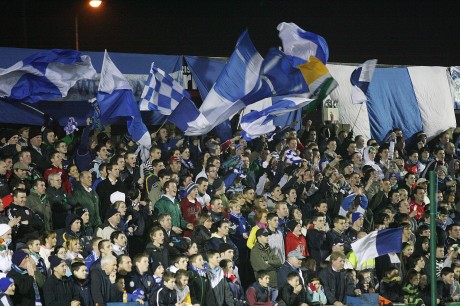Even though Ollie Horgan’s Finn Harps had just recorded a superb 3-1 win over St Patrick’s Athletic, the alarm bells chimed loudly at Finn Park on Monday night.
Club officials scurried out from the Finn Park clubhouse clearly perturbed by what they’d witnessed.
The Harps Board has been concerned about falling attendances for some time now, but on Monday night just 380 customers paid in to Finn Park to see Harps take on fellow relegation battlers Pat’s.
The crowd will record a marked increase tonight, when Harps clash with Limerick, but the draining of the crowds flocking down Navenny Street is still enough for the club to be growing increasingly worried about the footfall.
“We can’t sustain Premier Division football with these type of attendances – it’s that simple,” one club official said.
Granted, the game came after Harps endured a difficult run of results that included five consecutive League defeats while it took place a day after Donegal played Antrim across the road in Sean Mac Cumhaill Park with a lot of supporters simply not having sufficient disposable income to allow attendance at both.
Harps’ wage bill is believed to be north of €5,000 per week and, unlike most of their Premier Division peers, the Ballybofey club does not have a major financial backer.
Behind the scenes, Harps’ actual attendances are said to be ‘well below’ what had been projected at the start of the season and the outlook is worrying going forward in the short-term at least.
After tonight, Harps will have just three home games in a nine-week period until the end of July. They are due to face Derry City at the end of June, but that fixture will be shelved due to Derry’s involvement in the Europa League, meaning a potentially money-spinning tie is kicked down the road.
This morning, Harps Chairman Sean Quinn made an appeal for support tonight.
“This is a very big game for Ollie, the players and everyone at Finn Harps,” Quinn said.
“A big crowd backing them against Limerick is really needed. Despite where we are at in the table, the manager and the squad have kept working very hard to turns things around.
“We want to keep Premier Division football in Donegal, but we need the backing of our supporters coming through the turnstiles to do that. So I’m appealing to fans from all parts of the county to come out and get behind Ollie’s side tonight in Ballybofey because they really deserve it.”
Last season, Harps’ first in the Premier Division since 2008, saw the club average an attendance of 1,216.
Their lowest was the 551 that watched them against Cork City.
The 2016 season began with 4,195 jamming in for a 2-1 derby win over Derry. That dropped to 2,061 for a Monday night clash with Shamrock Rovers but the next game at Finn Park had just 739 for the visit of Longford Town.
After that Shamrock Rovers game, just five games broke the 1,000 barrier – including games against Dundalk (1,320), Sligo (1,671) and Derry (1,782) that had significant away support. The others against Bohemians (1,007) and Galway (1,030) were just over the 1,000 mark.
In the 2015 First Division season, Finn Park didn’t heave to its seams until the play-off against Limerick and in fact just once – when 1,155 saw a game against UCD – was the attendance in four figures and the average was 784 for that campaign.
Horgan’s first season as Harps boss, in 2014, averaged a crowd of 449. Monday’s 380 was the lowest crowd since 220 people clicked the turnstiles for a 0-0 draw with Cobh in July of that year – when 250 watched a 1-0 win over Waterford and 340 saw Harps lose 1-0 to Longford.
In 2013, a crowd of around 200 saw Harps held scoreless by Salthill and that season averaged a crowd of 479, while the previous season dripped to a low of 230 for a 3-1 loss to Longford and the 2011 season also had a crowd in the 200s, with 244 paying in for the 2-0 win over Mervue.
During Harps’ first stint in the Premier Division in the late 90s and early noughts, Finn Park averaged crowds of around 1,500 but in those days Harps also had a 500 Club – when supporters would pay five punts a week to be in with a chance of a share of a €600 prize fund – as a regular source of income, which acted as a good fallback during periods when home fixtures were scarce.
Tags:







